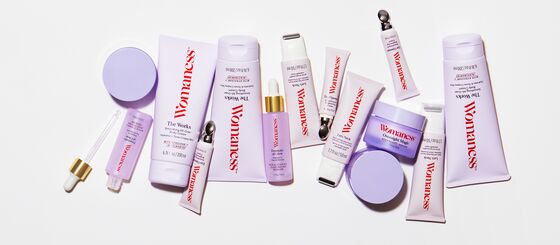The $600 Billion Market for Women in Menopause Is Fit for Disruption
The $600 Billion Market for Women in Menopause Is Fit for Disruption
(Bloomberg) -- Women of a certain age are now trending in the beauty industry, where youthfulness has traditionally been celebrated. In the the past three years, a steady stream of brands has hit the market to address the issues menopausal women face: hot flashes, dramatic skin changes, low libido, achy joints, and more.
Most focus on skin care and offer creams, serums, and masks because dryness is a major problem. Brands such as Emepelle, SeeMe Beauty, Caire, and LaMaria are largely offered directly to consumers with prestige price points and have a limited selection. Industry leaders Procter & Gamble and Avon have also begun trying to reach these consumers as well with their respective Kindra and Adapt lines. “It’s not a ‘keep it in the closet’ kind of conversation any longer,” says Dr. Orit Markowitz, a board-certified dermatologist and founder of OptiSkin in New York.
A new menopause wellness line, Womaness, aims to be more comprehensive. It officially debuted on March 1 but will arrive at Target stores in cities nationwide on Sunday, March 28. The thoughtfully designed packaging was meant to appeal to a sexy, vibrant woman at the height of her career. The collection will eventually include 13 products, but the first phase of the Target rollout will include four cheekily titled options such as the Me No Pause menopause relief supplement ($40), Daily V Soothe external vaginal moisturizer ($15), Here There Everywhere body wipes ($10), and the Gold Vibes vibrator ($25).
Supermarkets and drugstores offer a variety of feminine care products for menstruating women, but when it comes to the menopausal set, offerings remain slim. “There’s not one brand out there today that really speaks to the total solution of menopause that you can afford,” says Sally Mueller, cofounder and chief executive officer of Womaness.

The concept was born after Mueller, a former Target executive and chief brand officer for Clique Brands, found herself in an awkward conversation about vaginal dryness. The doctor handed her a pamphlet and essentially wished her luck. “I am never buying any of those products,” she said. “I thought: The names don’t speak to me, the ingredients weren’t clean and natural, and the packaging was horrible,” Mueller recalls.
During a business trip, she sat down for drinks with Michelle Jacobs, who had experience in licensing and branding, and they decided to team up. But their project is more than just products. “It’s really about having a place for a community of women to get information, inspiration, and most of all, education,” co-founder and Chief Operating Officer Jacobs explains. “So many people do not understand menopause, and it’s really up to women to sort of take control of their own health care and ask doctors—push doctors for more information—and make sure they’re getting the right facts.”

Menopause signals the end of a woman’s menstrual cycle and is diagnosed once she has gone 12 months without a period. The average age at which a woman enters menopause in the U.S. is 51, but the transitional perimenopause stage commonly happens in the 40s and can last for years.
As estrogen levels sink, vaginal tissue thins and can become irritated, leading to dryness and pain. “Estrogen is a significant part of vaginal functionality and is a hormone that increases blood flow,” says Dr. Jessica Shepherd, a board-certified OB/GYN who is also the founder of Sanctum Med + Wellness and chief medical officer of Verywell Health. “This decrease in blood flow will affect vaginal lubrication and how well the smooth muscle tissue layer is affected.”
According to a 2020 report released by venture capital firm Female Founders Fund, about 1 billion women worldwide are expected to be in menopause by 2025—a $600 billion opportunity for businesses. (Womaness is a bit more conservative in its analysis and estimates closer to $150 billion.) “She’s the wealthiest, healthiest, most active generation and only 5% of advertising dollars are spent directed to her,” Mueller laments. “I get chills thinking about how much money this woman has and how no brands are speaking to her.”

Every woman has a different experience with menopause, so the 13-SKU collection includes supplements, feminine care, and products for sexual health and skin and body care to tackle a wide range of issues.
Dr. Catherine Chang, a Harvard-fellowship trained plastic and reconstructive surgeon, says patients at her Beverly Hills, Calif., practice have been very vocal about what has happened to their face and body after menopause. “It is typically jowling, excess skin underneath the chin, loss of elasticity, and overall dullness and dryness.”
As Dr. Marie Hayag, a dermatologist and founder of 5th Avenue Aesthetics, puts it: “Estrogen is your BFF when it comes to your skin and youthfulness.” As estrogen and collagen levels drop, so does the skin on your face. In addition to flappy skin, women can also experience Pruritus (skin itching), an increase in facial hair and acne due to hormonal imbalances, and a decrease in body hair, including on the scalp.
Womaness’s remaining products will go online on April 21 and will reach stores this summer. The line is vegan; free of cruelty, nuts, and gluten; and was formulated without parabens, phthalates, sulfates, artificial colors, formaldehyde, mineral oils, estrogen, or added hormones. Womaness has also been tested by dermatologists, primary care physicians, and gynecologists.
©2021 Bloomberg L.P.

